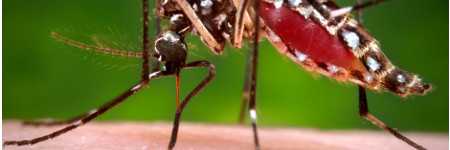Mosquito-Borne Diseases
Mosquito-borne diseases are those spread by the bite of an infected mosquito. Diseases that are spread to people by mosquitoes include Zika virus, West Nile virus, Chikungunya virus, dengue, and malaria.
Employers should protect workers and workers should protect themselves from diseases spread by mosquitoes. Although most people do not become sick after a bite from an infected mosquito, some people have a mild, short-term illness or (rarely) severe or long-term illness. Severe cases of mosquito-borne diseases can cause death.
Workers at Risk
Workers are at risk when they are working where mosquitoes are biting. Different species of mosquitoes are found in different geographic locations, are most active at different times, and spread different diseases. The risk to workers varies with
- where they are working in the United States or elsewhere
- type of habitat at the work site
- season
- time of day.
Workers at risk of being bitten by mosquitoes are those who spend time outdoors, including farmers, foresters, landscapers, groundskeepers, gardeners, painters, roofers, pavers, construction workers, laborers, mechanics, entomologists, wildlife biologists, and field workers.
Laboratory and clinical workers who handle infected fluids or tissues may also be at risk of infection. Transmission may occur through a break in their skin or via a sharp penetration injury.
What Employers Should Do
Mosquitoes breed in standing water. Employers should decrease mosquito populations at worksites by
- removing, turning over, covering, or storing equipment
- removing debris from ditches
- filling in ruts and other areas that collect standing water
- removing tires, buckets, bottles, and barrels that collect water
- placing drain holes in containers that collect water and cannot be discarded.
Employers can keep mosquitoes out of indoor worksites by ensuring that doors and windows have screens and are kept closed when possible.
Employers should also protect workers by providing
- training about:
- the risk of exposure to mosquitoes
- how they can protect themselves from mosquito bites
- symptoms of diseases spread by mosquitoes
- protective clothing, including long-sleeved shirts and long pants
- EPA-registered insect repellents to use on exposed skin and clothing
What Workers Should Do
Workers can reduce their risk of mosquito bites while working outdoors, by
- helping to reduce sources of standing water
- wearing long-sleeved shirts and long pants
- using EPA-registered insect repellents on exposed skin and clothing, as directed on the product labels.
Workers who develop symptoms of a mosquito-borne disease should report this promptly to their supervisor and get medical attention.
Resources
-
 CDC Avoid Mosquito Bites
CDC Avoid Mosquito Bites
Mosquito bites can be more than just annoying and itchy. They can make you sick. -
 CDC Insect Repellent Use and Safety
CDC Insect Repellent Use and Safety
Answers to common questions about the safe use of repellents. -
 NIOSH Fast Facts: Protecting Yourself from Ticks and Mosquitoes
NIOSH Fast Facts: Protecting Yourself from Ticks and Mosquitoes
Print or order this free card for easy access to important safety information. -
 California Department of Pesticide Regulation: Fight the Bite! Protecting outdoor workers
California Department of Pesticide Regulation: Fight the Bite! Protecting outdoor workers
Mosquitoes can carry diseases, including West Nile virus. The best way to avoid infection is to avoid being bitten. There are many steps employers and workers can take to make outdoor work safer. -
 US EPA Mosquito Control
US EPA Mosquito Control
About mosquitoes, prevention, repellents, and pesticides.
- Page last reviewed: March 21, 2016
- Page last updated: November 8, 2016
- Content source:
- National Institute for Occupational Safety and Health Education and Information Division


 ShareCompartir
ShareCompartir
